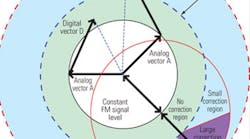Today’s modulated signals tend to exhibit large peak-to-average power ratios (PAPRs). As a result, power amplifiers (PAs) must meet strict linearity requirements to handle the wide signal dynamic ranges without distortion. With greater backoff, however, a PA’s efficiency will decrease accordingly. Envelope tracking can be used to boost low efficiency in the backoff region. It allows the amplifier’s drain bias to track the magnitude of the input signal envelope. Such an approach is examined in depth in the 25-page application note from Agilent Technologies, “Simulating Envelope Tracking with Agilent Advanced Design System.”
When the input signal is low, the drain bias can be reduced to allow the PA to operate closer to its optimal efficiency point. If the drain bias can be dynamically adjusted to decrease values when the input signal is lower, the PA can be operated at higher efficiency. The software-focused application note provides an overview of how the PA is characterized and then examines the modulated RF signal. Next, it shows how the PA can be simulated with a fixed drain bias. These sections lay the groundwork for the section on implementing envelope tracking using behavioral model components.
When using envelope tracking, power-added efficiency (PAE) will only improve slightly. The authors estimate typically about 24% versus 21.5%. This improvement will grow further (about 22.5% versus 15.7%) when an 11-dB constant-gain shaping table is used rather than a 12-dB constant gain. Different simulation results are obtained depending on the amplitude of the input signal and the shaping table. Performance also is affected by how the amplifier is biased.
The note moves on to cover the use of Ptolemy sources and sinks to simulate error vector magnitude (EVM) and drain efficiency, before delving into how the 89600 vector-signal-analyzer (VSA) software can be used to display results. It then investigates the modeling effects that influence distortion. Examples include the bias modulator’s finite slew rate, the timing skew between the RF and bias-modulation signal paths, and the finite bandwidth of the circuitry used to implement the bias modulator. The document shows three different ways to set up and run simulations. Both the viability and functionality of those solutions are proven through their application to a simulation of envelope tracking as applied to a transistor-level PA model.
Agilent Technologies, 5301 Stevens Creek Blvd., Santa Clara, CA 95051; (408) 345-8886.
